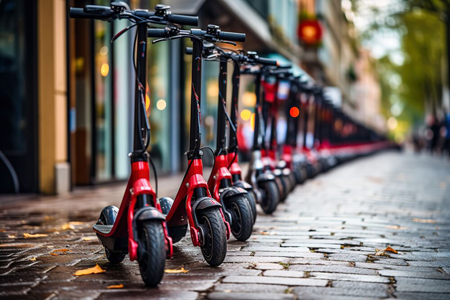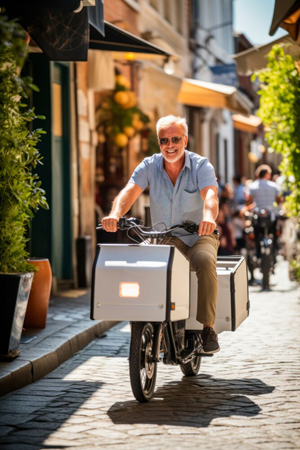
On March 11, 2024 in All, Automotive, General, Sensors by Mark Patrick
In the second blog of this four-part series, we will explore the role of micromobility solutions within urban infrastructure, the challenges faced when deploying rental schemes, and how technology can help resolve these issues.
1. Introduction
2. Urban Infrastructure and Micromobility
3. Personal Transportation and Consumer Challenges
4. How Technology Will Shape the Future
Cities and Micromobility
Many governments and individuals alike see micromobility as a new frontier bridging traditional personal and infrastructure transportation options. With solutions such as e-bikes, e-scooters, and cargo solutions that are able to access road networks, bicycle lanes, and footpaths, micromobility provides an agile and effective way to move around cities.
In its extensive 2020 report, the European Union Urban Mobility Observatory (formerly the EU Local Transport Information Service [ELTIS]) estimated that there are approximately 20 million e-scooter users across Europe.[1] The rapid deployment of e-scooter and e-bike rental services has reduced the demand on existing public transport networks—all at a fraction of the cost of expanding a traditional transportation system.
But despite this incredible success, urban micromobility solutions are not without complications, and improper deployment of the technology in some areas has had severe consequences.
Challenges of Urban Micromobility
Legislation and policymakers face the challenge of deciding what access electric micromobility solutions should have to roads, footpaths, and public transport networks. While many commercial micromobility solutions, such as e-cargo bikes (Figure 1), have been successfully adopted, there are concerns regarding the public’s use of e-bikes and, especially, e-scooters.

Performance and Infrastructure Concerns
The challenges of regulating e-bikes and e-scooters stem from two main angles:
Performance of the products: Many critics feel that the current 25kph speed limit the EU imposes on e-bikes and e-scooters is too fast for footpaths but too slow for roads. For regulators, this can make it hard to define what spaces these solutions can access. While cycle lanes are suitable, most cities’ networks lack sufficient coverage and need supplementing to complete journeys.
Volume of users: The attractiveness and popularity of electric micromobility has meant a significant rise in the number of bikes and scooters in cities, which, without additional infrastructure, has placed both riders and pedestrians at risk.
This increase has also been incredibly fast. For example, Stockholm went from having no rental e-scooters in 2019 to around 23,000 two years later.[2]
Paris’s U-Turn
Despite having Europe’s first shared rental scheme and 1.2 million riders per year, Paris residents recently voted 90 percent in favor of banning rented e-scooters.[3]
So how did it go so wrong?
In 2022, 459 injuries and three deaths resulted from e-scooter use, leading many Parisians to vote against them due to safety concerns. Complaints included multiple riders per scooter, speeding on pavements, and discarded scooters at parking stations.
Evolving Urban Micromobility
In response to public concerns about its rising number of largely unregulated e-scooters, Stockholm’s council announced in 2021 that it would halve its fleet and place an increased focus on analytical and technological measures that would help improve safety.
One such initiative is the smart allocation of parking zones to prevent piles of scooters. Riders are encouraged through discounts by operators to use quiet zones, as well as being asked to upload a photo of a correctly parked scooter.
Another is dynamic speed limits. When any rental e-scooter enters an area mapped as pedestrianized, its speed limit reduces to 6kph, and once the rider returns to a bicycle lane or road, it increases.
This allows scooters to use footpaths and roads at speeds better matched for both networks. However, the system relies on GPS, and accurate positioning in busy urban areas is incredibly challenging, with signals being offset or blocked by tall buildings.
Stockholm’s council reported that in some areas, including urban canyons and narrow regulation zones such as bicycle lanes next to pavements, current e-scooters were accurate to between 5 to 10 meters, but sometimes errors of up to 20 meters could be introduced.
As this could trigger a rider’s incorrect and dangerous slowing, the council determined the immediate solution was to remove restrictions in affected areas, and they pointed to updates in technology as the preferred future resolution.
Multiple Global Navigation Satellite System (GNSS) Approach
Quectel’s LC86G compact GNSS module is designed specifically to improve tracking in dense city environments compared to historic solutions (Figure 2).

While many GNSS modules concentrate on a single constellation of positioning satellites, the LC86G offers concurrent reception of GPS, GLONASS, BDS, Galileo, and QZSS. This increases satellite visibility, reduces location time, and enhances positioning accuracy, particularly in dense urban canyons where one constellation may be obscured, but another is visible.
Untethered Dead Reckoning
Another method to enhance e-scooter positional accuracy is to use an untethered dead reckoning (UDR) device. These use inertial sensors embedded within the module to calculate compensations in poor signal areas and bridge signal outages. One example is the u-blox NEO-M8U-06B UDR module (Figure 3).

This module integrates a highly sensitive 3D accelerometer and gyroscope and uses intelligent algorithms to combine this information with GNSS data to obtain real-time positioning.
Conclusion
It is clear that micromobility can play a key role in urban transportation. While in many cities there are necessary regulation and infrastructure changes to be made, technology can also have a significant impact.
Through accurate positioning systems, dynamic speed limits can be introduced, allowing e-bikes and e-scooters to move harmoniously through our cities. Equally, the management of rental systems can be enhanced by smart parking zones and overnight battery swaps, as opposed to returning scooters and bikes to the base for overnight charging.
Throughout this series, we will further examine the world of micromobility, with our next blog looking at personal micromobility solutions.
[1] “The Rise of Micromobility,” EU Urban Mobility Observatory, July 23, 2020, https://urban-mobility-observatory.transport.ec.europa.eu/resources/case-studies/rise-micromobility_en.
[2] “Data Driven Regulation of Micromobility,” City of Stockholm, February 2022, https://miljobarometern.stockholm.se/content/docs/tema/trafik/elsparkcykel/Data driven regulation of micromoblity.pdf
[3] Angela Giuffrida, “Parisians Vote to Ban Rental E-Scooters from French Capital by Huge Margin,” The Guardian, April 2, 2023, https://www.theguardian.com/world/2023/apr/02/parisians-vote-on-banning-e-scooters-from-french-capital.






